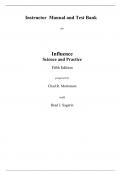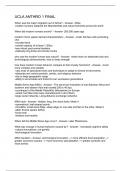Instructor Manual and Test Bank
for
Influence
Science and Practice
Fifth Edition
prepared by
Chad R. Mortensen
with
Brad J. Sagarin
, INSTRUCTOR'S MANUAL AND TEST BANK
Chapter One
Weapons of Influence
Teaching the Weapons of Influence:
Chapter one of Influence introduces the concept of controlled versus automatic responding (i.e.,
“click, whirr”). I have found it useful to discuss explicitly the dual-process models that underlie
this distinction—Petty and Cacioppo’s (1986) Elaboration Likelihood Model and Chaiken’s
(1987) Heuristic/Systematic Model (see Eagly & Chaiken, 1993, Epley & Gilovich, 2006, and
Petty & Wegener, 1999, for more recent treatments of these models). One way to structure the
material is as follows:
Social psychologists have suggested that there are two different ways we think about persuasive messages.
Sometimes we think hard about a message. We concentrate, and if we’re persuaded, it’s by the logical strength of
the arguments. Other times we don’t think much at all. Instead we’re persuaded by cues in the message or the
situation.
For example, if I see a New York Times article on the upcoming presidential race, and it’s a subject I care about,
I’ll sit down and read the article carefully. If the journalist presents good evidence and arguments, I may change
my attitudes.
Systematic processing:
• Occurs when we think deeply about a
message
• When processing systematically, we are
persuaded by the strength of the
arguments
• Systematic processing requires the
motivation and the ability to think deeply
about the message
Put up this slide. Note: I have found it useful to provide students with 6-per-page handouts of the overheads
at the beginning of each class period. This tends to diminish mindless note taking and increase class
participation. This is called systematic processing—when we think deeply about a message, when we’re
persuaded by the strength of the arguments. It happens when we have the motivation and ability to think deeply
about a persuasive message.
What happens if we don’t have the motivation or ability to think deeply about a persuasive message? When I went
to my first faculty meeting last semester, a proposal was brought up having to do with a fairly esoteric aspect of
the faculty year-end reviews. I didn’t really know what they were talking about, but after a somewhat heated
argument, a vote was called.
Most everyone voted against the proposal. What do you think I did? As with most questions I ask in class, I
wait for students to answer. I looked at what everyone else was doing and did the same. Why did I do this?
Copyright © 2009 Pearson Education, Inc. Publishing as Allyn & Bacon.
1
,INFLUENCE: SCIENCE AND PRACTICE, 5E
Heuristic processing:
• Occurs when we don’t think deeply
about a message
• When processing heuristically, we are
persuaded by cues in the message or
situation
• Heuristic processing often happens
automatically when we lack the
motivation or ability to process deeply
This is the other type of persuasion: heuristic processing—when we don’t think deeply about a message, when
we’re persuaded by cues in the message or situation—often automatically. It happens when we lack the
motivation or ability to process deeply.
With heuristic processing, we use shortcuts to come to a decision. Why don’t we think deeply about everything?
It’s hard! It’s unpleasant! Some researchers did a study of the electrical patterns of the brain while people
performed various activities. The activity with the greatest similarity to deep thought was when they had people
stick their hand in a bucket of ice water.
We can’t think deeply about everything. What sort of activities would be impossible with deep thought? Driving.
Sports…
Dual-process models of persuasion
• Systematic vs. heuristic processing
(Chaiken, 1987)
• Central vs. peripheral processing
(Petty & Cacioppo, 1986)
This distinction between the times we process systematically and the times we process heuristically forms one of
the Dual Process Models of persuasion.
I then hand out a sheet of questions and have students divide into groups of 3-4 to brainstorm answers. I
visit each group to guide and encourage, and when the groups are finished, we discuss the answers as a
class. Note: each student receives an 8 ½ x 11 version of the following sheet with space left after each
question.
Copyright © 2009 Pearson Education, Inc. Publishing as Allyn & Bacon.
2
, INSTRUCTOR'S MANUAL AND TEST BANK
Systematic vs. heuristic processing
Describe three heuristics/shortcuts we use to
help us make decisions:
1)
2)
3)
What is one situation in which we should try
to process systematically rather than using
heuristics?
What is one situation in which using
heuristics might get us into trouble?
I then discuss what may be the most pure example of a heuristic/automatic response demonstrated in social
influence research: Langer, Blank, & Chanowitz (1978). Note: here and in subsequent chapters, when I
make reference to research discussed in Influence, I include the slide I use, but to avoid redundancy with
the text itself, I do not elaborate on the specifics of the study.
I present Langer, Blank, & Chanowitz (1978) using two slides, and I write in “93%” on the second.
Langer, Blank, & Chanowitz (1978)
• “Excuse me, I have five • 94%
pages. May I use the Xerox
machine because I’m in a
rush?”
• “Excuse me, I have five • 60%
pages. May I use the Xerox
machine?”
Langer, Blank, & Chanowitz (1978)
• “Excuse me, I have five • 94%
pages. May I use the Xerox
machine because I’m in a
rush?”
• “Excuse me, I have five • 60%
pages. May I use the Xerox
machine?”
• “Excuse me, I have five •
pages. May I use the Xerox
machine because I have to
make some copies”
This should give us an intro to the systematic/heuristic model of persuasion. Influence is almost entirely about the
heuristic side (which I think is the more interesting).
Copyright © 2009 Pearson Education, Inc. Publishing as Allyn & Bacon.
3





